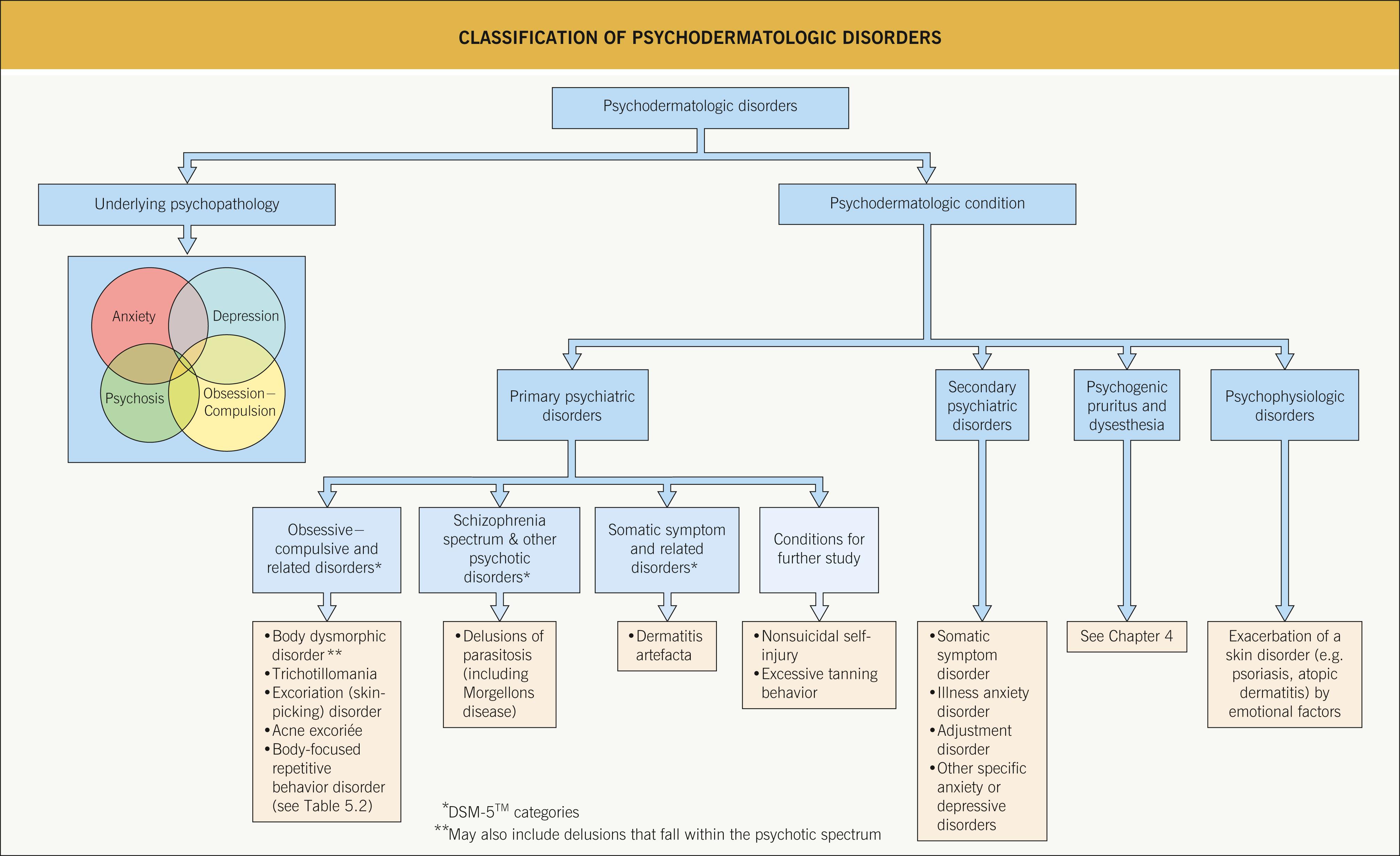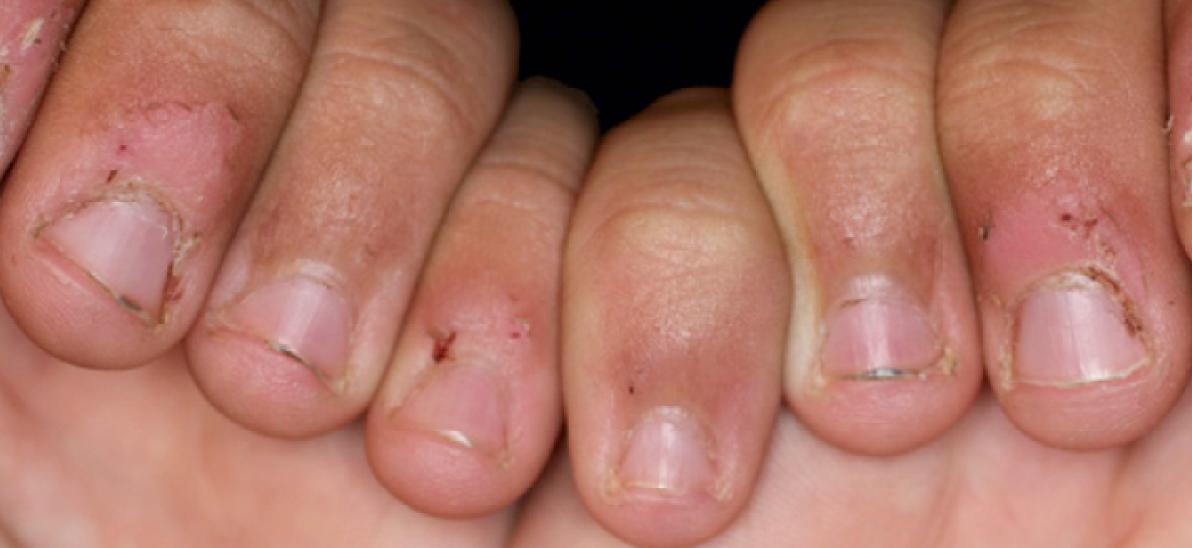Physical Address
304 North Cardinal St.
Dorchester Center, MA 02124
Psychodermatology refers to any aspect of dermatology in which psychological factors play a significant role.
Psychodermatologic disorders can be classified in two ways: (1) by the specific psychodermatologic condition or (2) by the underlying psychopathology ( Fig. 5.1 ).

Treatment is simplified by basing the choice of psychotropic medication or therapy on the underlying psychopathology ( Table 5.1 ).
| Treatment of procedural anxiety in adults (prior to procedure) |
|---|
| Benzodiazepines Diazepam: 10 mg orally 30 minutes prior Alprazolam: 0.5 mg orally 30–60 minutes prior Lorazepam: 2 mg orally 30–60 minutes prior
|
| Treatment of obsessive compulsive disorder (OCD) |
|---|
| Selective serotonin reuptake inhibitors (SSRIs) (in addition to cognitive behavioral therapy) |
|
| Treatment of delusions of parasitosis |
|---|
| Antipsychotics Pimozide: initiate at 0.5–1 mg/day and gradually (every 2–4 weeks) titrate up to 2–6 mg/day, if needed Risperidone: initiate at 0.5 mg/day and titrate up to 1–4 mg/day, if needed Olanzapine: initiate at 2.5 mg/day and gradually titrate up to 5–15 mg/day, if needed
|
The more commonly encountered primary psychiatric disorders in dermatology include body dysmorphic disorder, excoriation (skin-picking) disorder, acne excoriée, trichotillomania, other body-focused repetitive behavior disorders (BFRBD), delusions of parasitosis, dermatitis artefacta, and nonsuicidal self-injury.
Because many of these patients with primary psychiatric disorders present to the dermatologist and not the psychiatrist, it is important to establish the correct diagnosis and to offer appropriate treatment options.
Obsessions are recurrent and persistent thoughts, images, or urges that are intrusive and unwanted.
Compulsions are repetitive behaviors or mental acts that are performed in order to reduce anxiety or distress, especially that arising from obsessions.
In all of these disorders, the preoccupations and/or behaviors lead to significant distress or impairment in social, occupational, or other areas of functioning.
Some of these conditions feature body-focused repetitive behaviors (BFRB; e.g. hair-pulling, skin-picking; Table 5.2 , Fig. 5.2 ).
| Body-focused repetitive behavior | Associated mucocutaneous findings |
|---|---|
| Lip licking | Irritant contact dermatitis, secondary bacterial or yeast infections |
| Lip picking or biting | Multiple erosions or ulcerations, recurrent HSV |
| Cheek chewing or biting | Bite fibroma, morsicatio buccarum |
| Cuticle pulling, picking, or biting (see Fig. 5.2 ) | Paronychia, nail surface irregularities |
| Nail biting (onychophagia) (see Fig. 5.2 ) | Paronychia, nail dystrophy, subungual hemorrhages |
| Nail picking or pulling (onychotillomania) | |
| Habit-tic deformity of the thumbnail | Multiple midline Beau’s lines with prominent longitudinal central depression |
| Thumb or finger sucking | Skin maceration, dermatitis, secondary bacterial or yeast infections |
| Nose picking (rhinotillexomania) | Erosions, secondary bacterial infections |
| Trichotillomania | See text |
| Excoriation (skin-picking) disorder | See text |

BFRB become disorders (BFRBD) when the following criteria are met: (1) the repetitive behavior causes skin lesions; (2) there are repeated attempts to decrease or stop the behavior; (3) the behavior causes significant distress or impaired functioning; (4) there is no other underlying medical condition or mental disorder to explain the behavior.
Characterized by a distressing or impairing preoccupation with a nonexistent or slight defect in appearance.
On a psychiatric spectrum from obsessional to delusional.
Mean age of onset is 30–35 years; females = males; present in up to 10–15% of dermatologic patients.
Patients usually concerned with nose, mouth, hair, breasts, or genitalia.
Often adopt compulsive (e.g. numerous visits to physician for reassurance), ritualistic (e.g. excessive grooming routines), or delusional (e.g. multiple unnecessary surgeries) behaviors.
Consider and assess for this diagnosis in patients seeking multiple cosmetic procedures.
Rx: selective serotonin reuptake inhibitors (SSRIs) for obsessive–compulsive disorder (OCD) variant or antipsychotics for delusional variant.
Become a Clinical Tree membership for Full access and enjoy Unlimited articles
If you are a member. Log in here